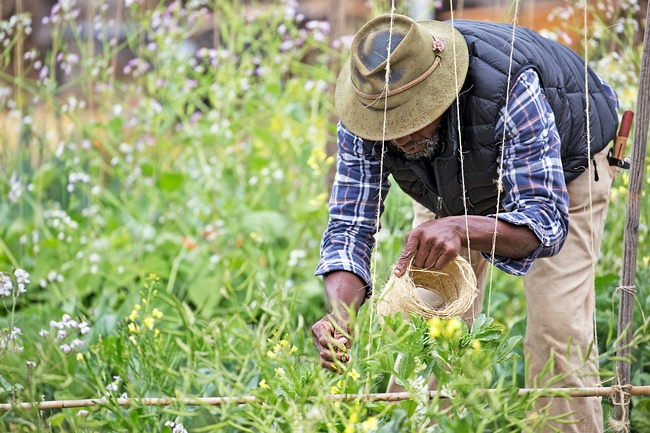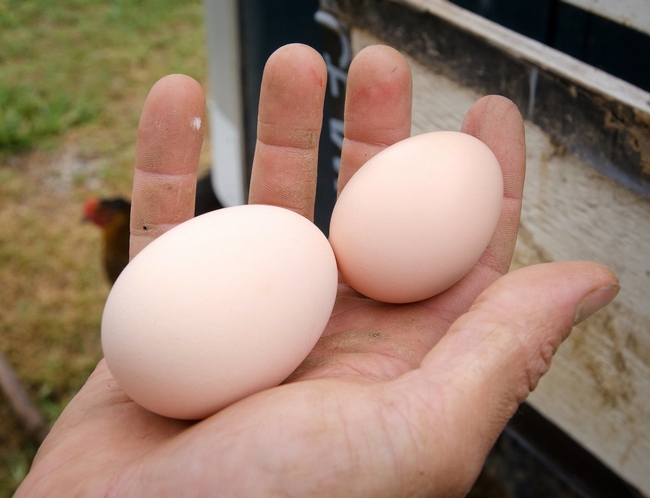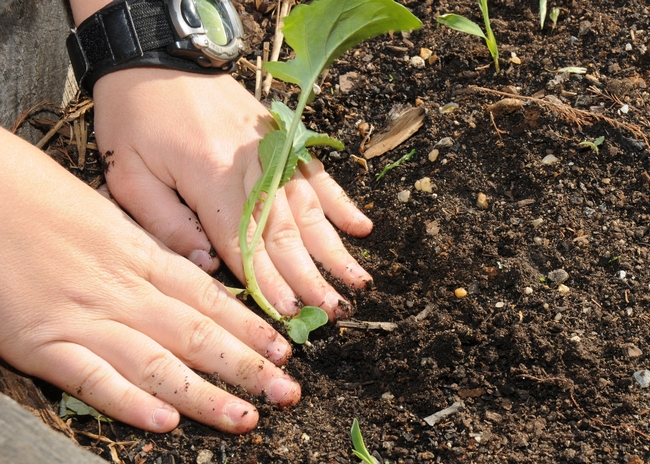Posts Tagged: Julia Van Soelen Kim
Smoke and ash from wildfire may have lingering impacts in food production
A summer of smoke and ash in many parts of California has raised questions about the safety of produce growing on farms and in the garden, eggs laid by chickens who peck around in ash-laden areas, and remediation needed to safely and effectively grow food in the future.
UC Agriculture and Natural Resources brought together experts who have researched the effects of previous fires' fallout and studied soil contaminants to share their insight in a two-hour webinar now available on YouTube.
“The No. 1 health concern during a fire is smoke inhalation, and it's been well documented that wildfire smoke can negatively impact both the heart and the lungs,” said Claire O'Brien, a pharmacology and toxicology doctoral student at UC Davis. “However, the chemicals found in the smoke don't just stay in the air. They can deposit onto plants and into soil and water.”
Although every fire is unique, some generalizations can be drawn from research conducted following previous fires. UC Cooperative Extension food systems advisor Julia Van Soelen Kim detailed a study conducted following the October 2017 wildfires in Sonoma County and across the North Bay.
With the help of UC Master Gardener and community volunteers, the researchers collected over 200 samples of homegrown collard greens, lettuces, kale and chard that were exposed to wildfire smoke and ash. A subset of the samples were analyzed by a private laboratory.
“There was very low concern about chemicals on produce,” Van Soelen Kim said. “No samples had detectable levels of lead, arsenic, mercury or chromium. And that's a huge sigh of relief.” However, analytical results vary by site, site history and by fire event, and few have pre-fire baseline data to compare with.
Van Soelen Kim said basic food-safety practices should be followed when preparing to eat food grown in a home garden, regardless of ash or smoke contamination.
“You should always wash your hands before and after harvesting, and wash your produce in running water to mitigate any kind of potential risk,” she said.
Are backyard chicken eggs safe to eat?
Another study outlined at the webinar used a similar process to determine whether there might be contaminants in the eggs laid by backyard poultry that live and feed in areas exposed to wildfire ash and smoke.
Scientists know from previous research that chickens exposed to lead in their environment can produce eggs with high lead content and that heavy metal content of ash from urban wildfires is higher than from rural wildfire.
“We combined those two pieces of research with what we know that chickens do all day: they peck at the ground for hours on end,” said Todd Kelman, a veterinarian in the School of Veterinary Medicine at UC Davis. “That makes for a pretty good hypothesis that urban wildfire could pose a risk for the production of eggs and poultry that contain heavy metals.”
Kelman and his team put out a call for eggs from backyard poultry and received samples from 344 premises in fire-affected and non-fire-affected areas of California.
Surprisingly, egg samples that contained higher lead levels came from parts of the state that were not directly impacted by ash and smoke.
“Did our data support our hypothesis that proximity to urban wildfire is a driving source for lead in eggs of backyard poultry? The answer is not so much,” Kelman said. “So, is it safe to eat eggs from your backyard poultry? We can't give you a definitive answer to that question. But we do suggest you assess your risk and reduce the risk of contamination.”
Practices that reduce the risk include keeping chickens off the ground, using a chicken feeder that prevents spillage onto the ground and making calcium readily available, for example in the form of oyster shells, because calcium can prevent the absorption of lead. Making sure that chickens are provided uncontaminated water is also an important part of risk reduction.
For confirmation on the safety backyard chickens and their eggs, lab tests for eggs are available for $60 from the California Animal Health and Food Safety Laboratory at UC Davis, or chickens may be submitted to CAHFS for necropsy.
Are soils safe for growing food after a fire?
Fire effects on soil is another consideration in burned areas, said UC Cooperative Extension urban agriculture advisor Rob Bennaton.
“Fires heat topsoil layers. They reduce the amount of living micro-organisms at the site of the burn, and also affect organic matter and nutrients. Ash deposits over time may make soils more alkaline,” he said. “As a result of these combined factors, there are temporary changes in nutrient levels and the capacity for soils to exchange nutrients for optimal plant growth and nutrition.”
With proper land care and management, soils can be remediated over time.
“It won't happen overnight. Soils were developed over millions of years,” he said.
Some ways to improve safety when gardening in fire-affected areas including keeping the soil covered with wood chips or other landscape mulch to reduce airborne soil dust. Use drip irrigation to prevent up splash onto the undersides of growing vegetables. Promote good drainage, especially at the bottom of slopes to prevent the concentration of contaminants.
Lab tests are often needed to determine the soils' post-fire characteristics. “Don't guess, but test,” Bennaton said.
The UC Master Gardener Program can provide technical assistance to help home gardeners find resources for home soil testing, he said.
Additional resources and information shared during the webinar include:
Post-fire soil resources and soil testing information
- UCCE publication on Soils in Urban Agriculture with soil testing & sampling information
- The UC ANR Healthy Soils Website, which has many resources worth reviewing.
- Tips for Interpreting Soil Analysis
- UC Master Gardener of Sonoma County 2018 workshop video “Effects of fire on soil”
Post-fire food safety
- Research on produce safety and backyard chicken egg safety after the 2017 wildfires in California is available on this web page. To view a past webinar recording with these research findings, click this link.
- Poultry wildfire resources from the UC Davis School of Veterinary Medicine:
- Best Practices for Produce Safety After Fire
- Understanding Risk: A community guide for assessing the potential health impacts of locally grown produce exposed to urban wildfire smoke
Firewise and sustainable home landscaping design in the defensible space zone
- Visit the UC Master Gardener Program of Sonoma County firewise landscaping web page.
- For a recent firewise & sustainable design and maintenance video by the Resilient Landscapes Coalition.
Impact of smoke & ash on plants
[This article was first published Nov. 3, 2020]
Farmers get a taste of the possibilities of value-added farm products
When you're in a jam because you've grown more apricots than you can sell before the fruit quality deteriorates, what do you do? Make apricot jam!
Farmers, food artisans, agricultural support organizations and representatives from Sonoma County agencies recently gathered to share ideas for creating small-batch and artisanal “value-added” products featuring locally grown fruits and vegetables. On Nov. 3, UC Cooperative Extension hosted “Taste the Possibilities: Adding Value to Your Ag Business” in Sonoma County.
“Value-added production is an emerging food trend with the potential to help grow the local economy and support farmers' livelihood by tapping new revenue streams from preserving the peak of harvest and farm seconds that may otherwise go to waste,” said Julia Van Soelen Kim, UC Cooperative Extension advisor for the North Bay Area.
Farmers shared their inspiring success stories and business people provided insight on sourcing local produce, using commercial kitchens and co-packers, obtaining the right permits and registrations, and leveraging best practices in business planning and marketing.
There are new and emerging opportunities for value-added production including Cottage Food Operations, which allow individuals to prepare and package certain shelf-stable foods in home kitchens, and the recent Sonoma County zoning-code change that allows small-scale agriculture processing on farms.
But not everyone has the time, interest or ability to make the products themselves, said Merrilee Olson, a specialty food producer who participated in the workshop.
Her business, PRESERVE Sonoma, does custom co-packing services and private labels for growers and food entrepreneurs. As a co-packer, Olson makes value-added products in her commercial kitchen and cannery. She also helps food entrepreneurs connect with farmers and other sources of local produce.
“I started this business to help farmers get value-added products made,” said Olson, who opened in 2011, before the cottage food law passed. At that time farmers were losing money to overproduction and they didn't have very many options.
When a farmer found himself with an extra 1,500 pounds of ripe apricots, Olson turned them into apricot jam, which he is selling at the farm's store and farmers markets. Some people come to her with old family recipes and their own ideas for products. For tomato growers, she has made pasta sauce, salsa, tomato soup and bloody mary mix. “The bloody mary mix was the farmer's idea, and that will be on Whole Foods shelves,” Olson said.
“The idea of value-added products is well-known to farmers, but they may not know they don't have to do it themselves,” Olson said. “Some farmers don't really want to make the product, they want to farm. Even if you have a well-equipped home kitchen, making cottage foods isn't for everyone and you need insurance so it's easier to pay someone else to do it. We are a licensed cannery, which means we can make products like pickles, which are not covered in the cottage food law. ”
Olson thinks of the value-added farm products as preserving a way of life as well as food.
“Many farmers weren't aware of the range of options for value-added production that can help them use the abundance of their harvest, diversify their operations and generate new income for their ag businesses,” said Karen Giovannini, UC Cooperative Extension agricultural ombudsman in Sonoma County who helps local farmers expand their agriculture enterprises and navigate the regulations and permitting needed to do so.
“These emerging opportunities support farmers and food entrepreneurs, as well as regional economic development, and help to build a more robust local food system,” said Van Soelen Kim, who specializes in food systems for Sonoma County as well as Marin, Mendocino and Napa counties.
The workshop was offered as part of the “Opportunities in Ag Business” series presented by UC Cooperative Extension and Sonoma County Department of Health Services and was sponsored by American AgCredit. The educational workshop series aims to help make family farming economically viable, inspire the next generation of farmers, and support the development of a vibrant local food system.





